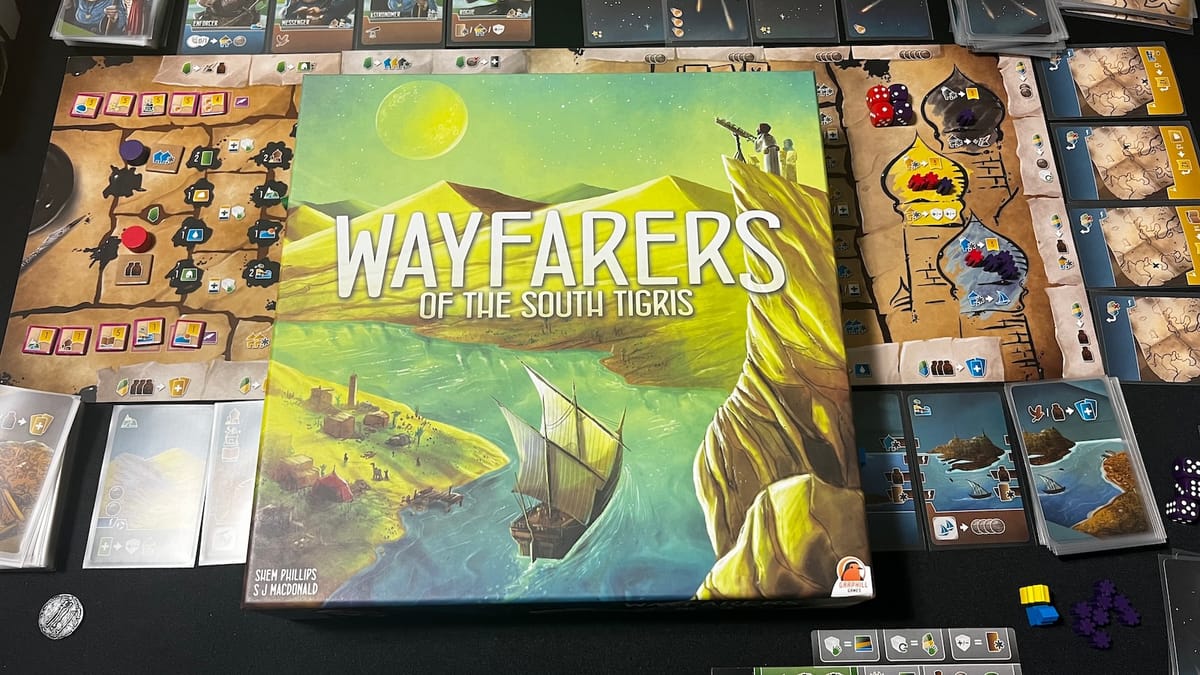
From the creators of the North Sea and West Kingdom trilogies, comes the first entry in the planned South Tigris Trilogy from Garphill Games. In the 9th century, scholars left the city of Baghdad to explore and map the surrounding countryside, waterways, and the stars. In Wayfarers of the South Tigris, players manage resources, dice, and workers to research and collect cards to score the most points by the end of the game.
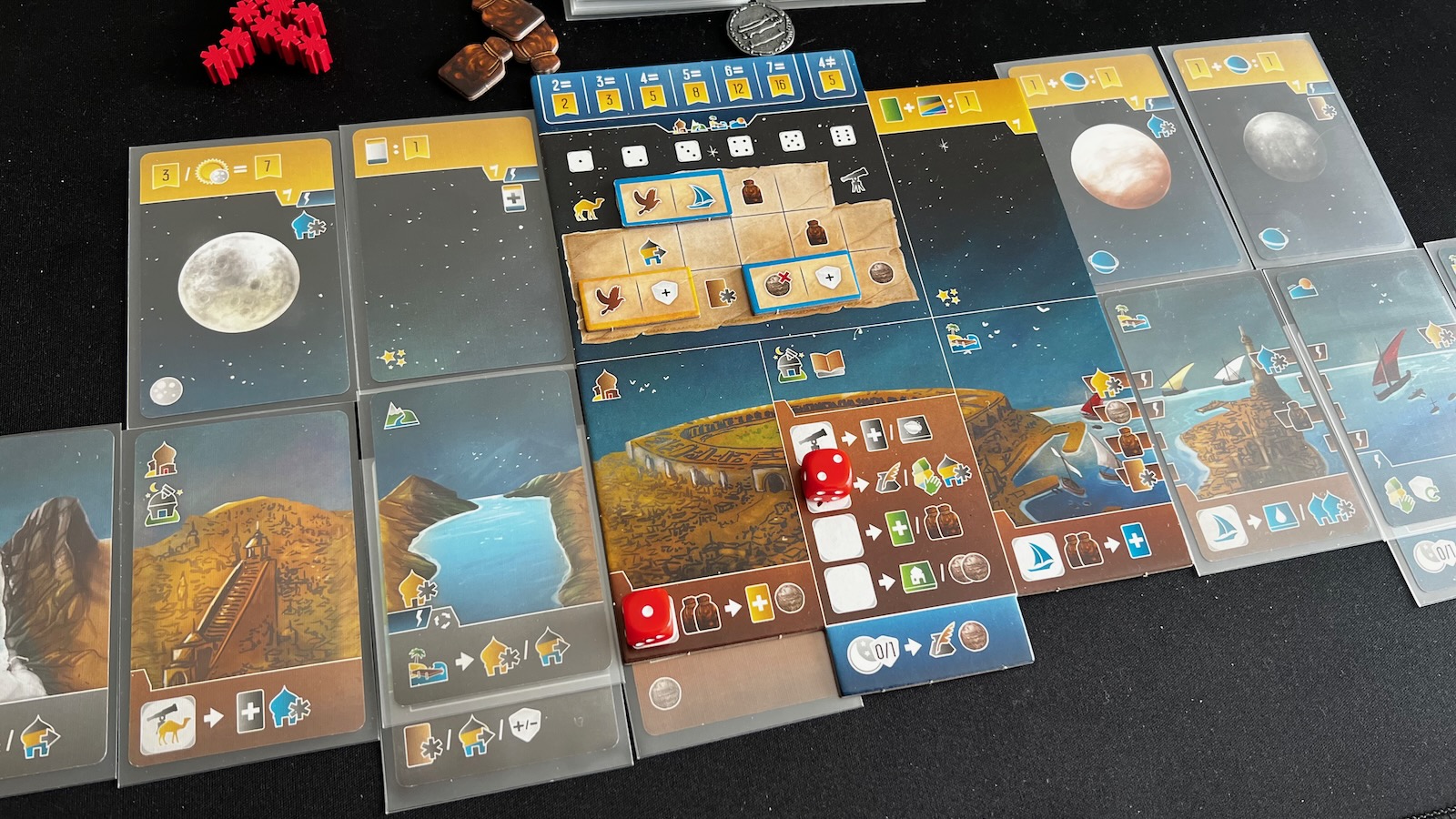
Player board and card tableau
To give some context, this is the third trilogy of games from Garphill games and designers Shem Phillip and Sam MacDonald. While each game is stand alone and plays differently, mechanisms and themes weave a common thread throughout each trilogy. In the original North Seas viking-themed trilogy, players first worked as Shipwrights to build a fleet of boats to explore distant lands, and a planned “redux” version of Shipwrights is being designed and will be released in 2023 or 2024. Raiders of the North Sea, arguably the best in the series, has players building crews and raiding outlying villages. The final entry, Explorers of the North Sea, has players sailing and exploring new lands to gain treasure and fulfill different goals. The West Kingdom trilogy, taking place in the medieval world, wove in themes of corruption and virtue, allowing players to embrace the righteous or the corrupt path through each game. Architects of the West Kingdom has players building up the kingdom and throws in an element of fun by allowing players to arrest and collect bounties on other players. Paladins has players defending the kingdom in a game that feels much more like multiplayer solitaire but with some great synergies. In Viscounts, players choose how to rule the kingdom, introducing a rondel movement system and an assembly line type card tableau offering players bonuses depending on the cards in play.

Journal board early in the game.
Wayfarers introduces the mechanics of dice placement and manipulation. Dice will also be used in different ways in the planned Scholars of the South Tigris in 2023 and Inventors of the South Tigris in 2024. In Wayfarers, players use dice as workers that can be placed in a variety of different spaces on individual player boards and cards acquired throughout the game.. In the rulebook, rather than going step by step through player turns, the designers discuss a lot of the different concepts at work in the game first. By the time you get to the player’s turn, you know why you are taking the actions, and the instructions flow smoothly. There is also a great iconography page on the back of the rulebook to help players during the game. What better way to continue with this review than to follow their lead.
TAGS
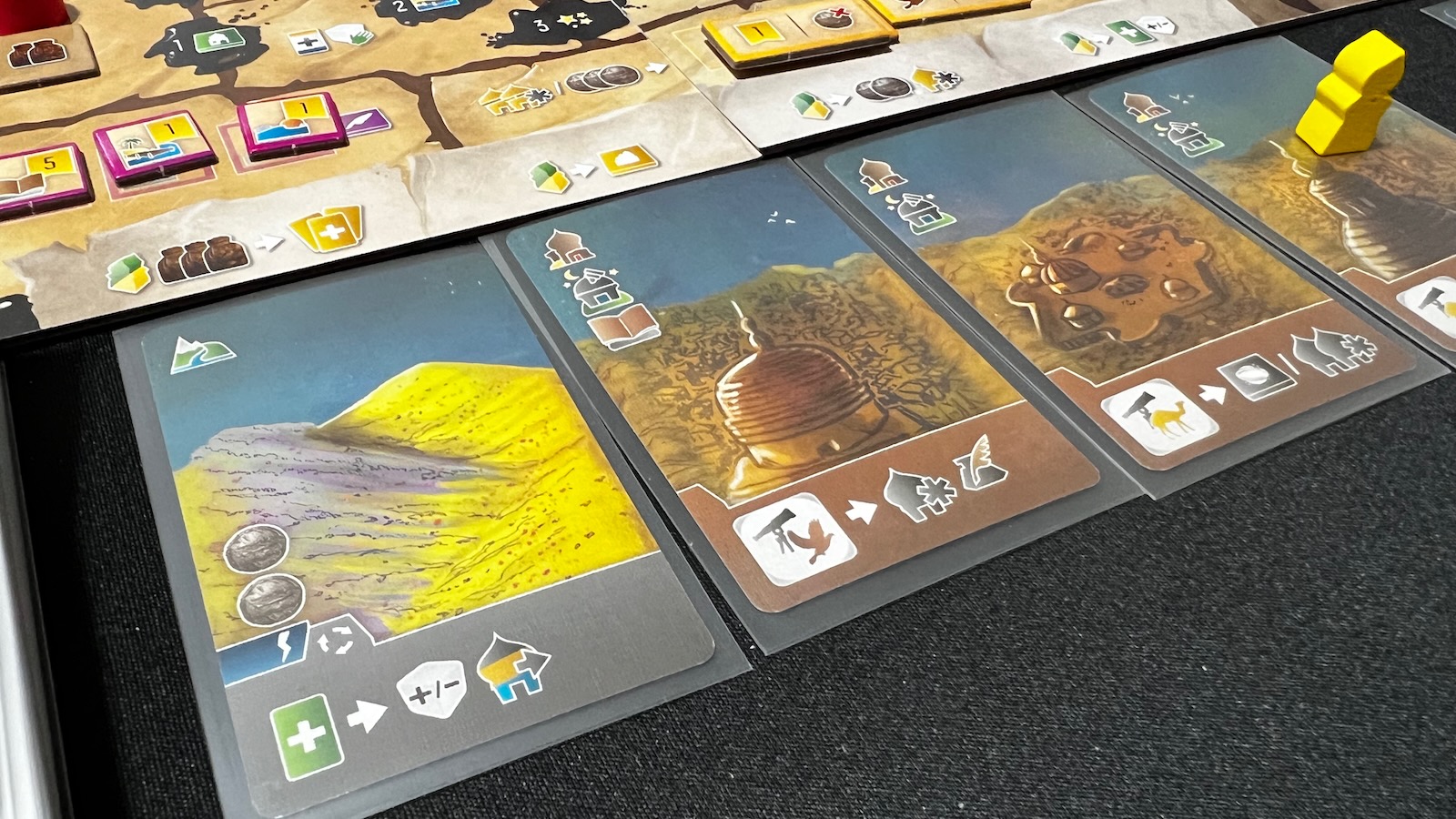
Land cards featuring different tags. Worker placement actions visible on the edge of the board.
Wayfarers utilizes tags in different ways throughout the game. On land cards, you will find cities and vistas and water cards feature harbors and open water. These four tags will earn players end game scoring points for sets of the same tag and sets of the four non-matching tags. Observatory and library tags will also be found on land and water cards and work with other end scoring. There are also a variety of space tags that will earn players points depending on the different combinations they have at the end of the game. Tags can also be found on upgrade tiles that will sometimes be the most efficient way of finding what you need when the cards you want are appearing.
INFLUENCE & GUILDS
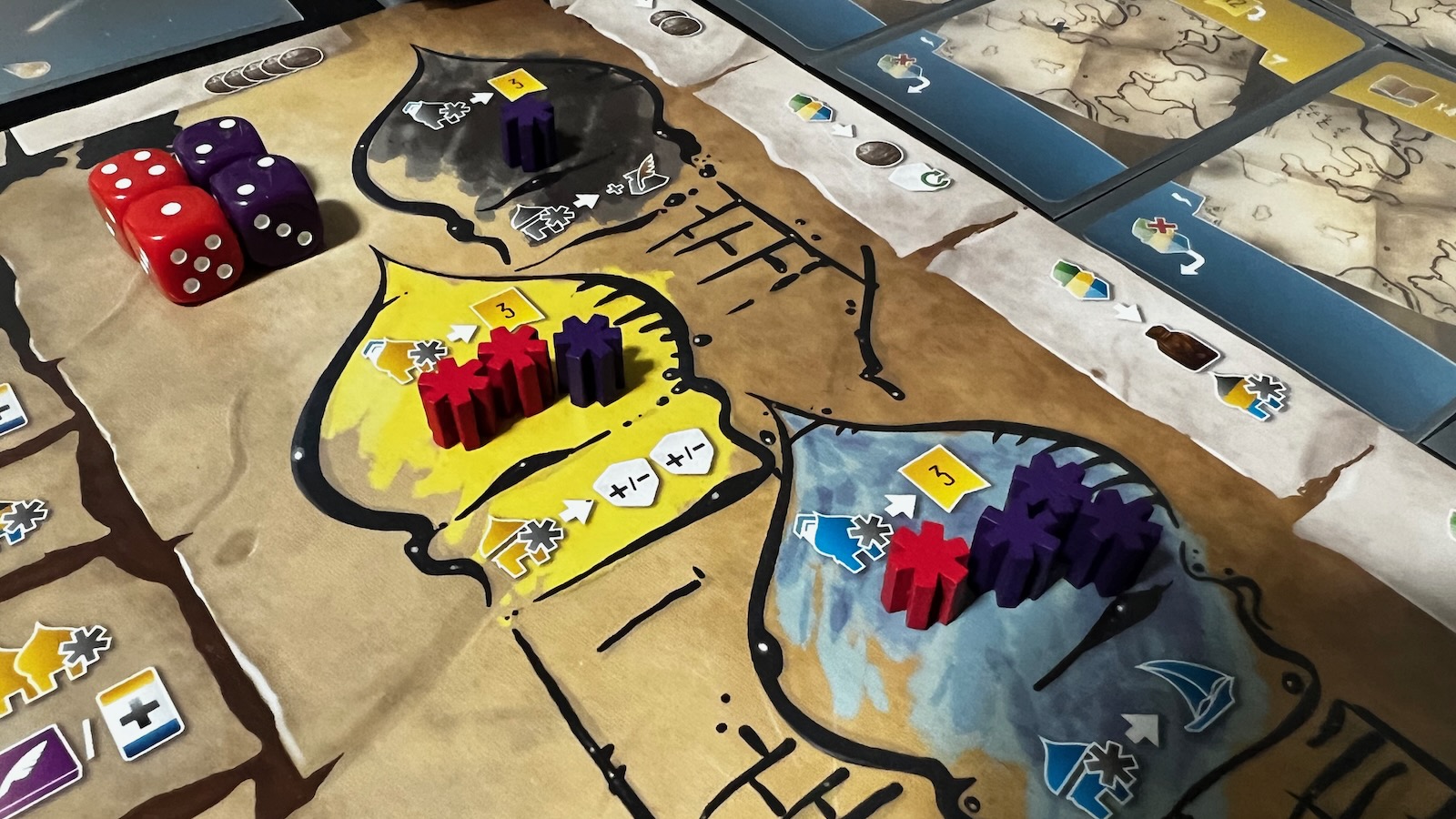
Guild influence spaces. Players have an opportunity to gain more dice throughout the game and the extra are stored next to the guilds.
Players have 15 influence tokens to use in the game. Influence can be placed on cards causing other players to pay silver or resource tokens to use an influenced card. Players also place and move around influence tokens on three guild spaces on the main board. Once per turn, players can remove an influence to utilize a guild’s special ability. The black Space Guild allows players to journal a second time when the journal action is activated. An influence removed from the yellow Trade Guild allows players to change the value of their dice twice. The blue Exploration Guild gives players a Ship tag when placing dice on the board, but more on that later. Influence is a fun way to manipulate how other players may take turns by pushing them towards specific actions. The player with the most influence in each of the guilds at the end of the game will also score some extra points.
JOURNALING
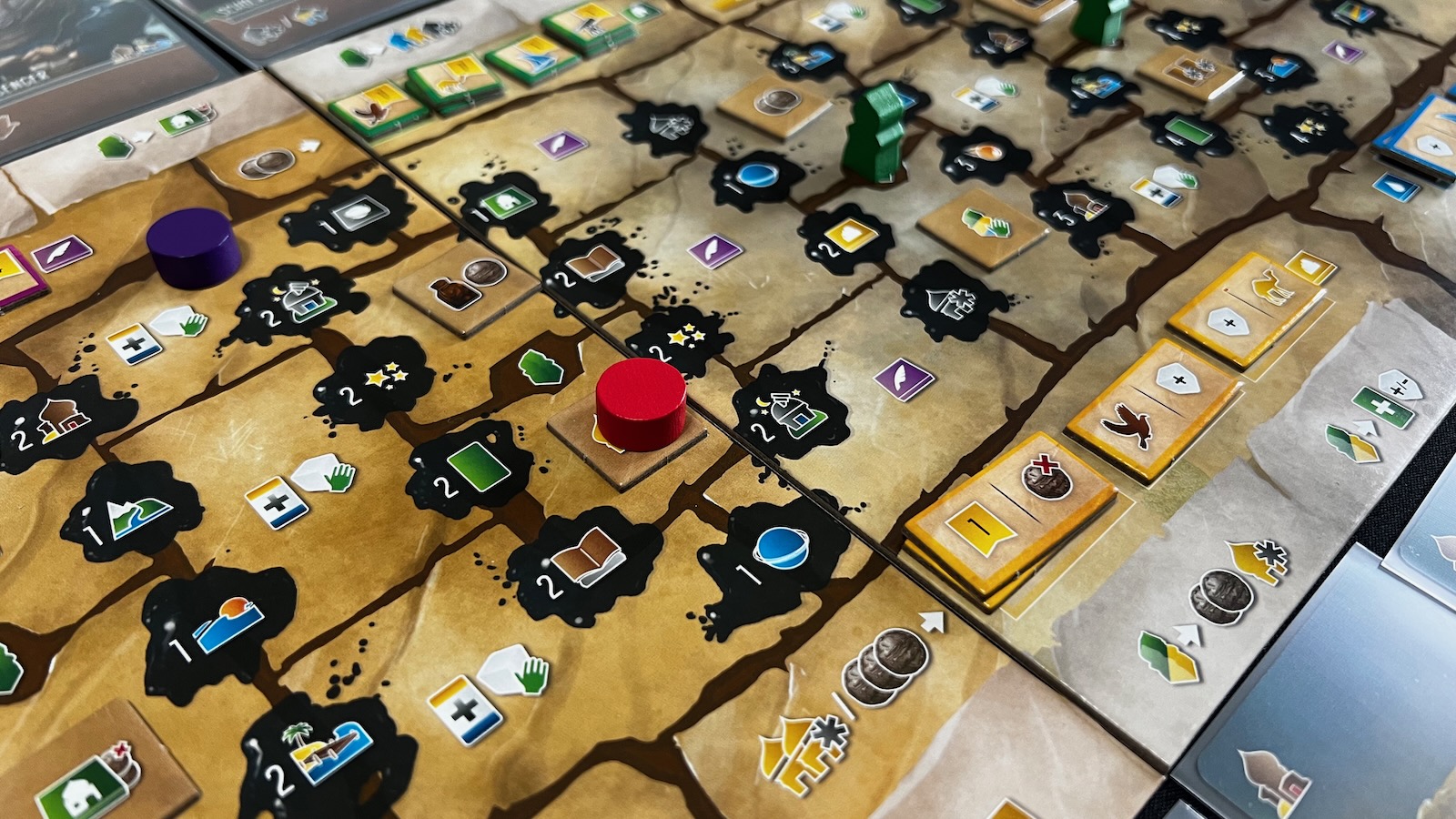
Journal board.
As players explore the unknown, they have to come back and journal. The journal is featured on the three main boards and are double sided to allow for variable set-ups. A number of spaces on the journal board also have movable pieces allowing for different set up combinations each time you play. At various times, players will take a journal action, moving their player token across the board. Most movements require the players to have collected something like a set of tags or a specific amount of one type of card. Each space also features a bonus that players gain by moving on the space. Removing an influence from the black guild allows a player to journal twice, if they have the requirements to do so. Journaling is also the way the game ends. When a player gets their token to the last space, each player gets one more turn, including the player who triggered the end game.
CARDS
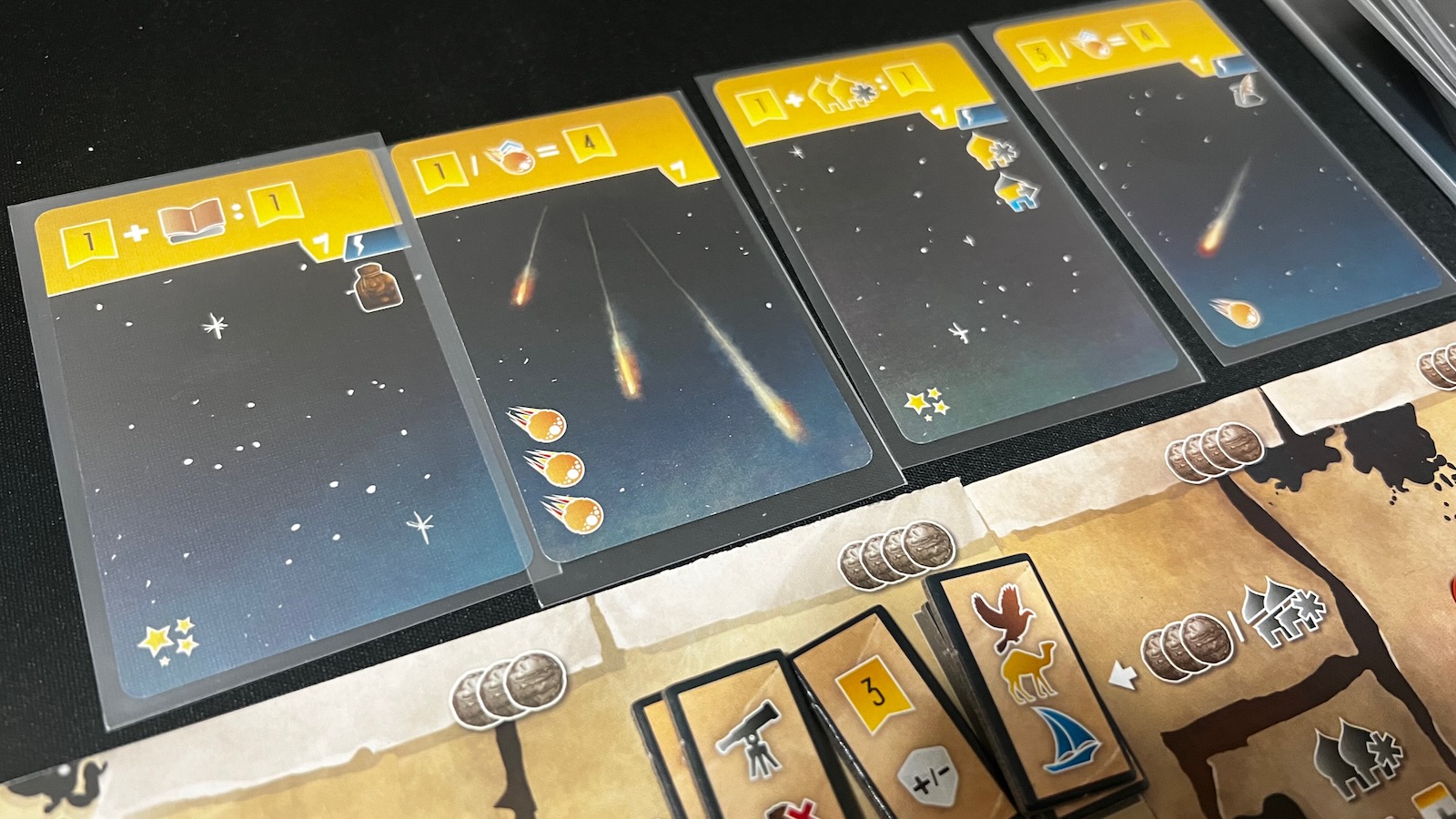
Space cards feature different end game scoring conditions.
Wayfarers comes with 5 different types of cards that give different abilities when activated. Cards are acquired in a variety of different ways and usually involve spending silver or provision tokens to acquire. All cards are stored alongside the individual player boards to form a tableau that the player will interact with throughout the game.
Land cards come in two types: Cities and Vistas. Cities open up a new spot to place a die and Vistas give ongoing bonuses when certain conditions are met throughout the game. Water cards also have two types with Harbors giving a new dice placement spot and the Open Water giving one time benefits to the player. Water cards also have synergy bonuses that are activated when symbols line up on the card edges when attained. Both land and water cards are placed on the sides of each individual player board.
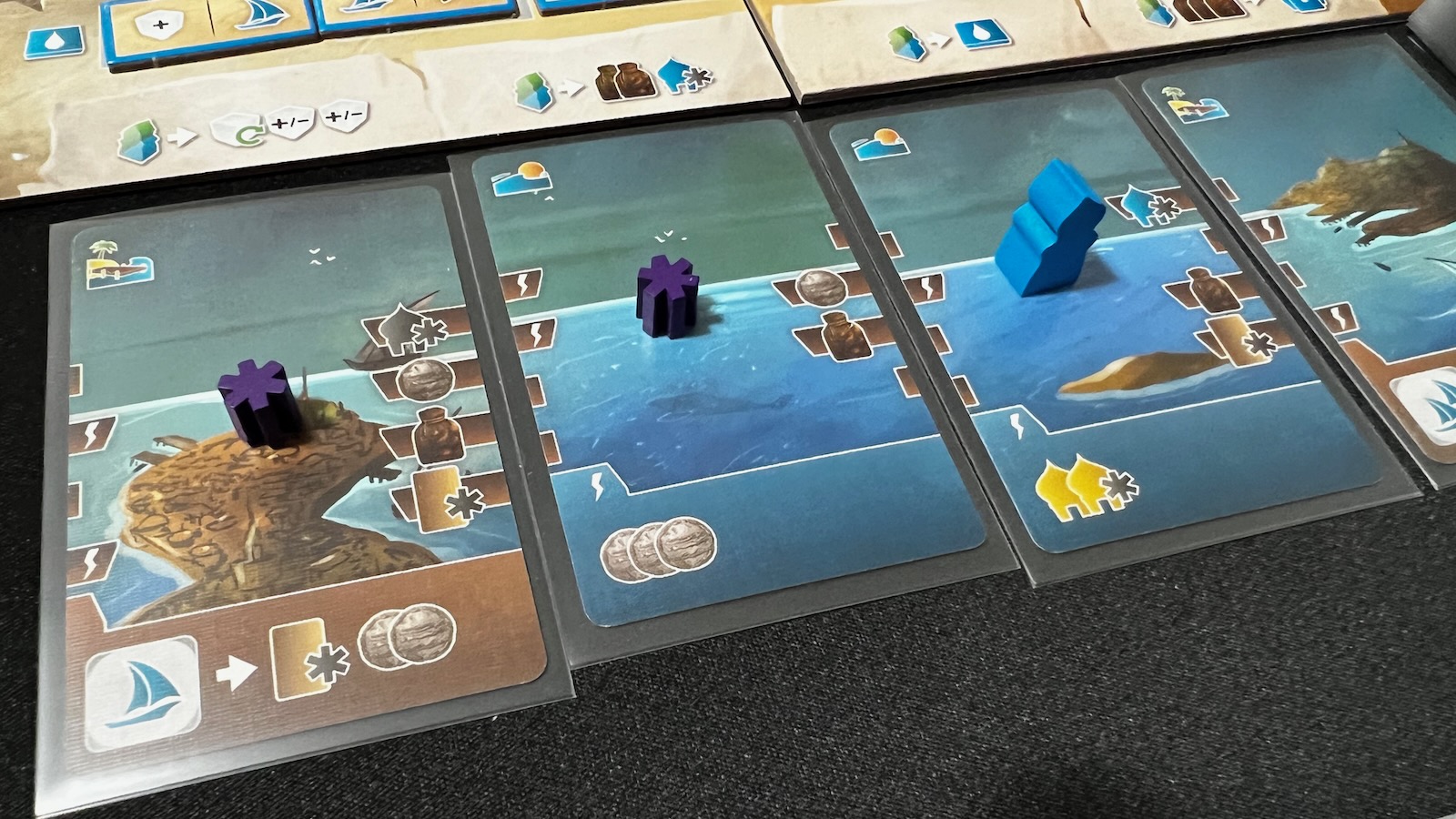
Water cards have harbor and open water tags and can take blue and green workers for actions on the edge of the board.
Space cards feature a variety of tags and are acquired for end game points. The Sun and Moon are singular cards in the deck and can give big points if a player has both. Planets power up the more a player has. Comets each have their own point values, but the player with the most comets at the end of the game powers all his comet cards up to 4 points each. The Stars are the most common but each gives a special condition to activate the end game bonus, usually in the form of certain tag sets or number of cards of a certain type.

Inspiration cards can optimize space cards and can also take one of each type of worker.
Inspiration cards can power up Space card bonuses. Each Inspiration card has its own activation condition and is placed above a space card. If the condition is met by the end of the game, the card will double the points of the attached Space card. Inspiration cards can also be discarded when attained to take one of the special board actions described later.
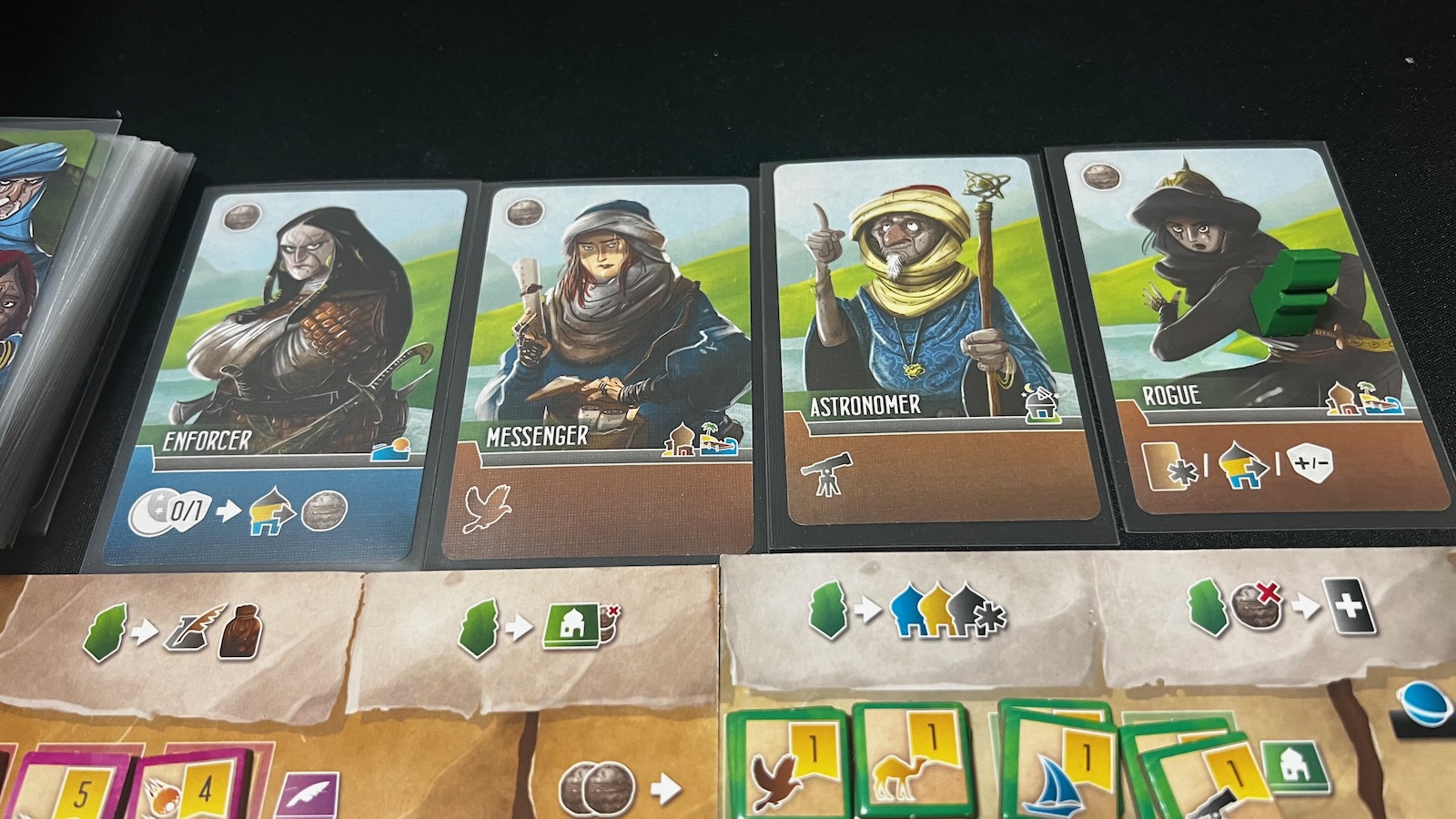
Townsfolk cards and green worker placement actions.
The final cards are the Townsfolk. Townsfolk are placed underneath the Water and Land cards and add special bonuses when those cards are activated. Townsfolk cards can also power up the ‘rest’ action that players take when they need a reset.
UPGRADE TILES

These are special upgrade tiles featuring tags from the cards.
Each time a die is placed back into a player’s supply, they must roll it and keep the number rolled. Each number has a variety of abilities as shown on a player’s caravan on their player board. Upgrade tiles help power up the abilities of the dice in the player’s control. Some dice placements require a special tag for the dice to be placed and activate the card. Upgrade tiles add these tags and other abilities to the different dice faces. Other abilities are dice face manipulation, discounts when spending provisions or coins, end game points, and some feature tags that can combine with those found on cards for end game bonuses. When placing an upgrade tile, covering symbols printed on the caravan will give players some one time bonuses.
PLAYER TURNS
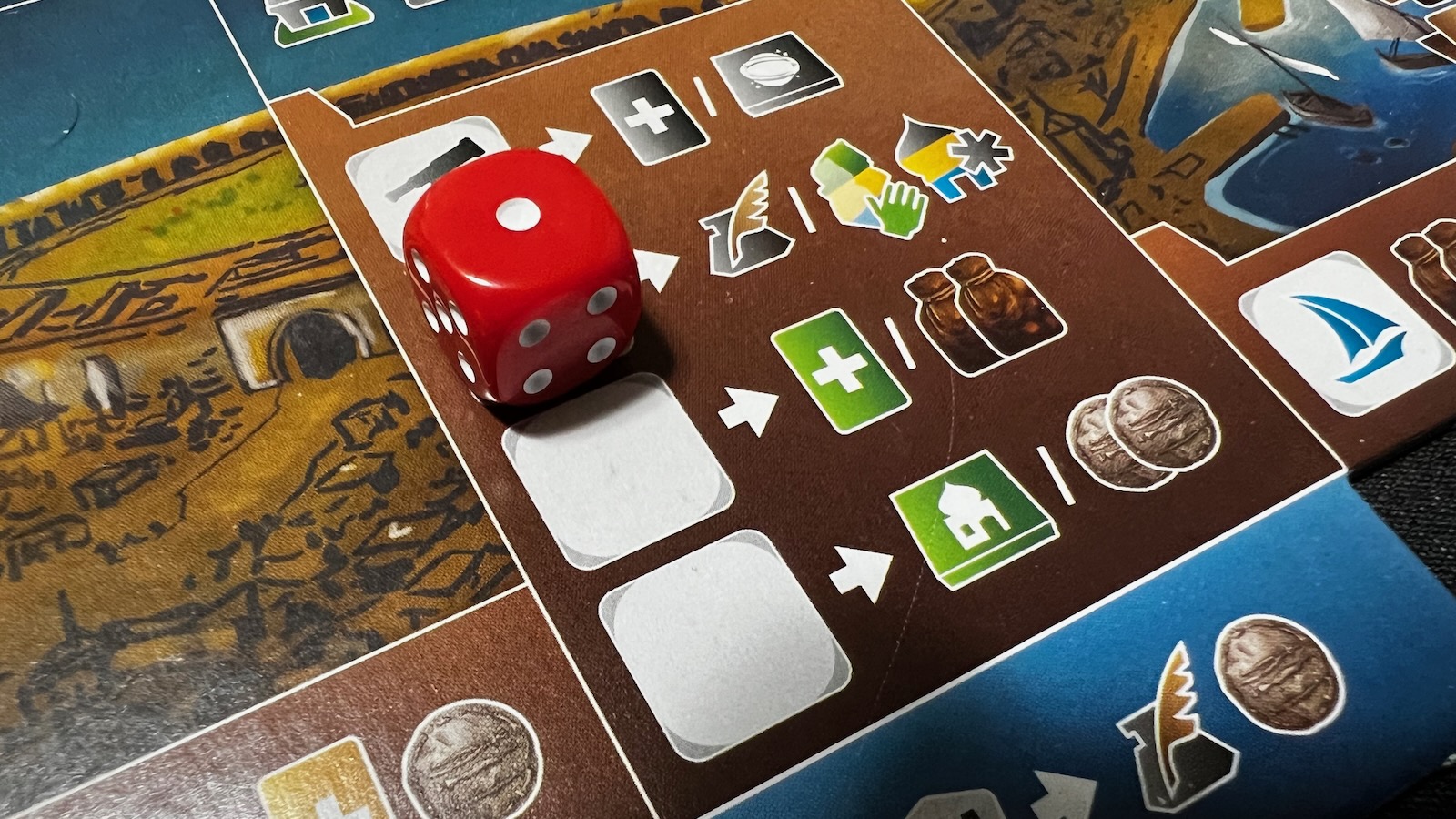
Player board dice placement actions.
Players can do one of three things on their turn: Place a die, place a worker, or rest. Placing a die activates a card’s ability or one of the few pre-printed abilities on the player boards. Players must make sure they have the associated tags to place in some spots. Workers are placed on the card markets surrounding the main board which each have an action associated with them. The yellow, blue, and green workers have a limited number of spaces they can be placed, but this is the main way players will attain cards, upgrade tiles, and extra resources. When players are out of dice or workers or any other reason they may have in their heads, they can rest. Resting allows players to retrieve their placed dice, which are then rolled and placed in their supply, gain a coin, and journal. Added townsfolk can also improve the resting action. The resting bonuses, apart from retrieving dice, are only gained if a player rested with one or no dice in their supply.
OVERALL IMPRESSIONS
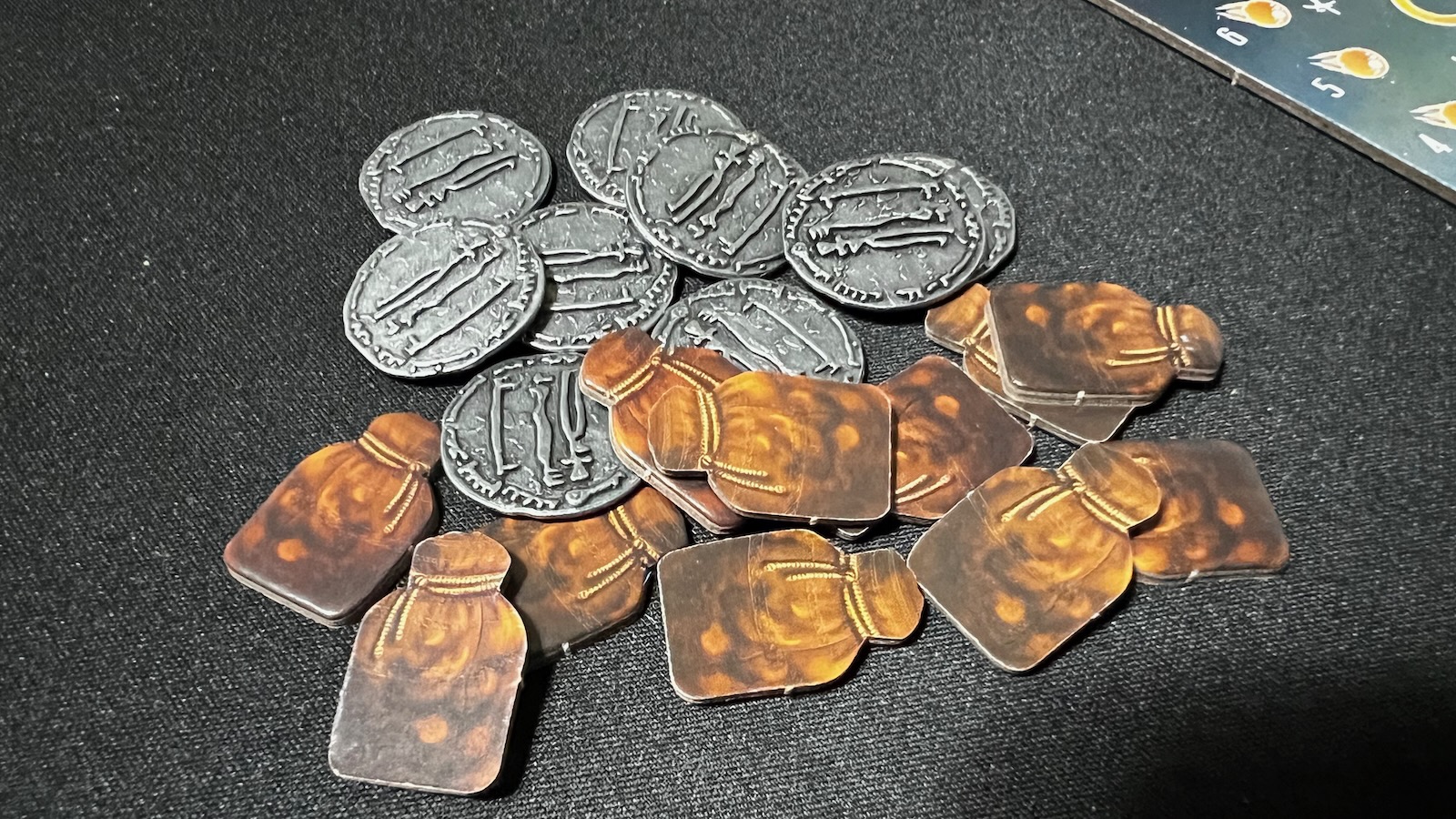
Provisions and upgraded coins specifically for the South Tigris series.
The production quality for the game is what you would come to expect from Garphill Games. The iconography is clear and uses familiar images from past games. The iconography is featured on the back of the rulebook for a quick reference, and it doesn’t take long to understand what everything means. The designers brought back Mihajlo Dimitrievski to do the artwork, as he did with the other two series, and he continues to bring a welcoming aesthetic to the game. The familiar look of the townsfolk is like greeting old friends in different costumes. The inclusion of double sided main boards and player boards adds a variable element that is not seen in many Garphill games. Each player board has a different layout of caravan bonuses and the ability to change journal tiles around on the main board makes each game a little different. The only thing I would change about the production is the box insert. The upgrade tiles are small cardboard bits and they are difficult to get out of the insert when setting up. There are extra spots that would make it easier, but I’m holding out hope that those are meant for a future expansion. The main board and player board components do not make a very tight seal on the player pieces in the insert so each game I am constantly having to re-sort player pieces by color and get them back where they belong.

Caravan featuring a variety of upgrade tiles.
The gameplay of Wayfarers is classic Garphill goodness. The worker placement elements, familiar in past trilogies, get a new spin with dice placement and the need to upgrade those dice as the game goes on. I’m not always a huge fan of matching tags in games, but this one did not seem overly convoluted and out of reach. Each tag had a specific purpose and it did not seem like activating one action activated fifty other things I had to keep track of on my turn. As suggested in the rulebook, looking ahead on the journal track helped me through my first few games to give me an idea of what to do next. For example, the next journal space requires three blue upgrade tiles, then what do I need to do to get those tiles and advance? As more games got played, you found different ways to utilize space cards and the tags you have to synergize end game points. More experienced players still needed to move down the journal track, but didn’t necessarily need to race to the finish to get a winning score. The influence mechanic is also a lot of fun. When feeling like you are stuck, there is usually a way to get out of it by taking a yellow influence to get the dice face you need or jump ahead a bit by taking a black influence when journaling. The biggest frustration for me in the game is not seeing many cards at lower player counts. There are some mechanisms to get into the decks, but most require tag upgrades and money to use which can be frustrating in the early parts of the game when the market isn’t looking pretty. This really affects the space market which only cycles when someone buys a card. Higher player counts move through the cards on a consistent basis.
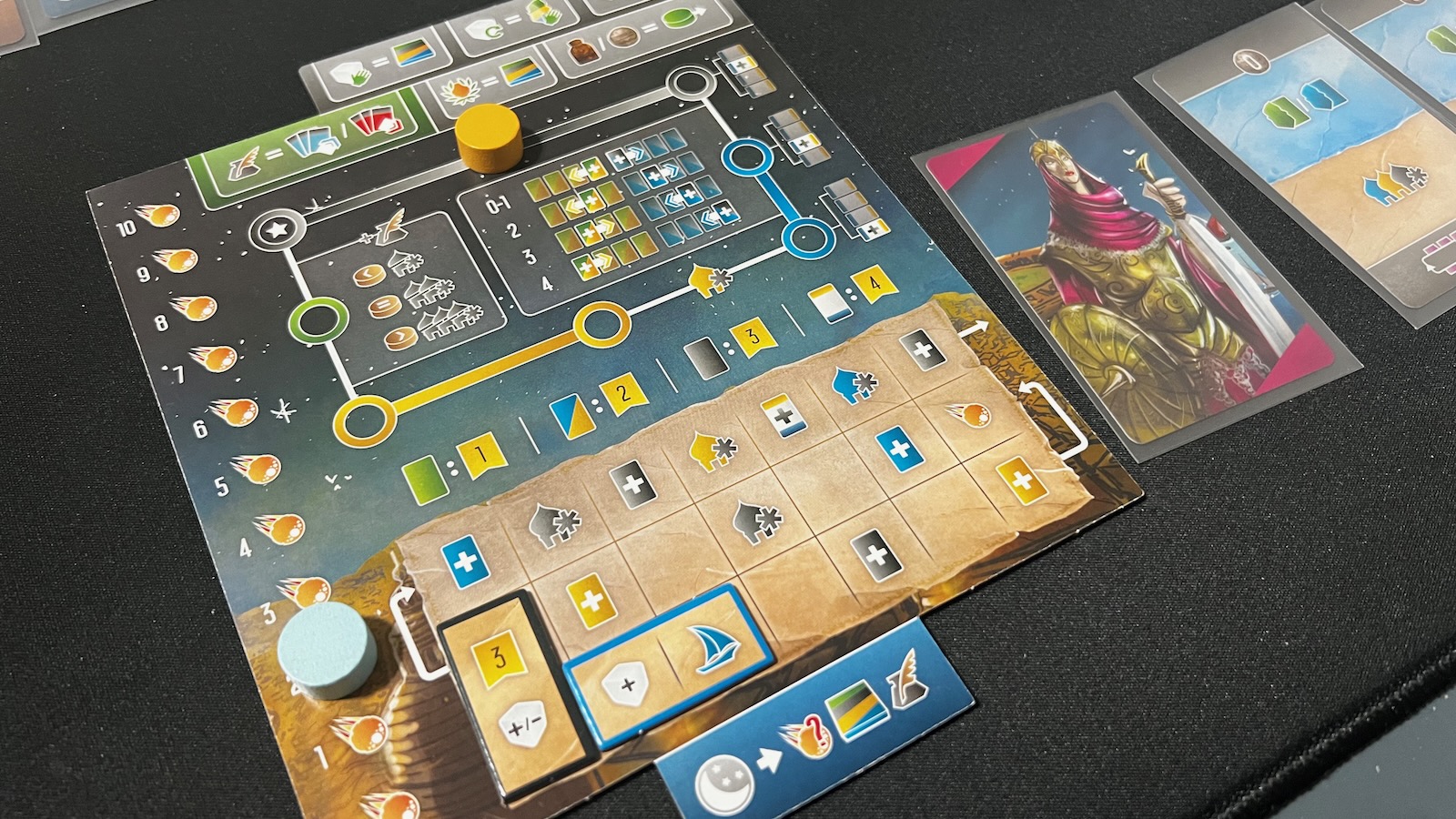
AI solo board. This AI focuses on upgrade tiles.
Another element that impressed me was the solo mode. The solo mode was easy to pick up and understand and played much like a two player game without much change. The backs of each of the four player boards introduced a different AI bot that focused on a different element of the game to score their points. Do they go after the upgrade tiles or journal or are they hungry for space or townsfolk cards? Each turn, a card from the AI deck is flipped and determines the AI actions. A token will move around a central track that helps determine which color card or upgrade tile the AI targets. The variability allows you to go up against a variety of different opponents and adjust to their strategy to win, which didn’t happen often.
Overall, the guys over at Garphill games hit it out of the park. Wayfarers introduces some fun new concepts, but keeps some of the same feeling from the previous trilogies. The mechanics are easy to pick up even when the decisions aren’t always easy to choose on your turn. This probably isn’t something I’m going to get a new gamer to play, but will definitely satiate the pallett of someone wanting a little strategy mixed with a little luck from the roll of the dice. The variability of the set-up and the different player counts from solo to four will give you a different game each time Wayfarers hits the table, and that experience isn’t bad.
Wayfarers of the South Tigris
Excellent
Head to the South Tigris in the first entry in Garphill Games new trilogy. Wayfarers has you collecting cards, upgrading and utilizing dice, and managing resources and workers as you explore the unknown lands, waters, and skies. A medium to heavy worker placement and tableau builder for fans new and old to the genre.
Pros
- Dice placement and upgrades a fun twist on worker placement
- Easy to follow card and tile tag combos
- Great art and iconography make it easy to get into the game
Cons
- Card cycling at lower player counts
- Box insert doesn’t keep everything together
- We still have to wait for an expansion and the next game in the series
